“We Have Lost So Much Elegance”
A Professional Stylist Speaks Her Mind
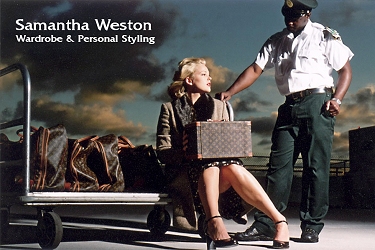

|
Samantha Weston is a professional freelance stylist who specializes in working with plus-size models. While Ms. Weston is a consummate professional who styles for the top agencies in the industry, she also brings an artist’s sensibility to her work, and allows her compelling world-view inform her styling choices. Her comments about fashion and its role in our culture, about male attitudes towards plus-size models, and about the most celebrated names in the industry, are illuminating and highly entertaining. Ms. Weston can be reached via e-mail at SamSTYL@aol.com. HSG: How long have you been a stylist, and where might we have seen your work? SW: I’ve been a stylist for about eight years, and you’ve seen my work on the cover of Sexy At Any Size, which is a book that Katie Arons did about her plus endeavours. I’ve assisted for BBW. And most of my work is found on comp cards of the greatest plus-size models in the business. Or at least I think they are. 
HSG: Such as? SW: Tracie Stern. Liis. I did Yanderis’s new card before she went up to New York. Barbara Brickner—I finally got to work with her. I was so excited about that. I’ve been hearing about her for so many years. Normally, most of my work is a lot of testing for agencies. I’ve worked with Irene Marie in Miami. I worked with Wilhelmina in New York. I’ve worked with Ford in the past. I keep these girls in business because I keep changing their looks and their cards every season. HSG: How did you become a stylist? How did you get into this line of work? SW: Ever since I was a kid, my favourite thing to play with were Barbie dolls, or any kind of doll. But I didn’t like a doll unless you could take her clothes off and re-dress her. And if I didn’t have something to re-dress her in, I would just kind of make something. I went to school for fashion design, and didn’t love it, so I switched to a merchandising major and I got a degree in fashion merchandising, with a minor in design. I always had a gift for being able to walk into a store and go through racks and racks of crappy clothes and just find the best thing there was, and pull it out, or match a colour. I have an extraordinary gift for matching colours when they’re not in front of my face, which is hard. And I’m a neurotic about it. If it’s not perfect, I won’t wear it. And I feel the same way about my work. If it’s not perfect, I don’t want a girl wearing it. HSG: It’s so interesting to hear the way you talk about colour. It’s rather the way an artist would speak of mixing colours on a canvas. SW: I definitely consider myself an artist. My first job, I worked for a photographer, and he actually introduced me to plus, which was nothing back then—a teeny, tiny blip that nobody had even heard of. At the time, I was plus sized myself, so I figured, well, if I knew how to dress myself, then I could dress somebody else. And I was introduced to Dorothy from Plus Beauty, and Ricardo, who formerly ran the division at Irene Marie. And I did a test for them, and they liked my work, and that’s really how I started doing this. 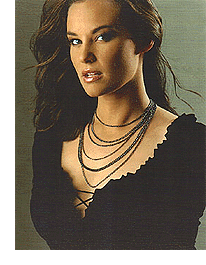
HSG: So what does a stylist contribute to an image? SW: I contribute her clothing, her shoes, her accessories. Depending on who the photographer is, and what the shoot is for, sometimes I give input on location. HSG: Do you ever get involved with the hair and makeup? SW: It’s not my field. I’ll talk to whoever is doing the hair and makeup about what I see, what they see, how something’s going to work with the clothes. Communication on a photo shoot is really the key. HSG: How do you decide what’s best for a shoot? Do you orient yourself by the look of the model, or do you have a wardrobe idea in mind, and wait until the right model comes along to wear an outfit? SW: Basically, a girl will call me, and she might give me some ideas about what she wants. But if the clothing in the store doesn’t speak to me, I’m not going to pull it. My job is to make these girls look phenomenal, to make them sellable to their clients. I want to show a model’s versatility in her looks as well. HSG: So it’s not just a matter of perfecting one single look that’s right for the girl. SW: No, it’s not. I usually do three or four different kinds of looks for her, depending on her market, and also what’s in fashion. 
HSG: Is that important—for a model to change her look periodically? SW: If you’re making a mark as a red head with big, piercing blue eyes, then that’s your look. But you can change your style. And you can change your markets, too. You can start out as a younger girl in the junior market, and as you grow up, and grow into yourself as a model, go for a more sophisticated kind of look and market. I spend a lot of time talking to the bookers to find out what markets they’re trying to hit, and the model as well, to be able to cover what they’re looking for. Editorial is totally different than catalogue. HSG: What would be the difference between styling editorial versus commercial? SW: Editorial, I would go for a more unusual look of clothing, obviously, or something a little more avant-garde, something that’s not necessarily the norm, something you wouldn’t see every day on a girl. Whereas when I do commercial, you want to see that a girl can work a suit, or a casual look, or a pair of jeans, or a skirt. HSG: Now, would you say that in choosing outfits for a shoot, you inspired by the model’s look, or by the photographer’s style…? SW: Absolutely. The model, or the clothing, or the thought of the clothing on the model. If I find something that’s absolutely spectacular, I’ll buy it and put it away until the right girl comes along— 
HSG: —just knowing that someday, the appropriate girl will be there. Do the photographers have an input on the styling choices? SW: They really let me handle that. Sometimes the agents will give me ideas. They’ll send me pictures. They’ll find magazine spreads that they like, and say, “We really like this; can we do something like this?” And I do what I can to duplicate it—but not so much duplicate it, as recreate it. HSG: Filtered through your own vision. SW: Absolutely. HSG: Yes, I imagine that it’s hard and not very fulfilling to merely Xerox someone else’s work. SW: I have to tell you, I have a big problem because a lot of stylists on the Beach go to wardrobe houses, rental houses, and everyone ends up wearing the same clothes, and they reuse this, and they reuse that, and I don’t reuse my clothes. Every now and then a piece that’s phenomenal will get reused in a different way, or a basic, but you wouldn’t be able to tell from picture to picture. Or a pair of shoes. And for testing, the girls do bring some stuff down with them. I do have some standards that I always ask the girls to bring. I like to add my own personal touches as well, sort of my little signature to my work. 
HSG: What would be an example of a Samantha Weston “signature”? SW: I love antique. So I’ll throw in a hat, if I can, or a purse, or an antique sweater. I have a wardrobe collection from a size 14 pretty much down to a size 10, and I think I’ve used almost everything in my personal collection in a shoot at some point. HSG: Again, it sounds almost like an artist’s approach. It seems that you think of it as more than “just a job.” SW: It’s not just a job. It’s a passion. And there have been many times when I’ve stopped and thought about getting out of this business because it was slow, and then I think, well, what else am I going to do? So I’ve been branching out a little more into production work, and I do work for straight-size girls, and I do men’s work, and I’m good at it, but quite frankly, I don’t have the love and the passion for doing it as I do working with the plus girls. HSG: So what is it about plus-size models that you particularly love? SW: I’ve maybe had an incident with one girl who I didn’t get along with, and we didn’t see eye to eye, and that’s it. And I think that’s a pretty good track record. Other than that, it’s been smooth sailing. And I have a policy—and all the agents know this—if they don’t like what they get, I’ll reshoot it. I’ll try it again and pull new clothes. But the plus girls are very nice. I think a lot of straight-size girls take stylists for granted because they’re all over the straight-size industry. 
HSG: And to find someone who’s really good at plus… SW: I have never met anybody else who specializes in plus. I know that there were people who worked for MODE, and I know that there are people who work for BBW, but they have magazine-based jobs. I’m a freelance plus stylist. I have people who ask me about it all the time. People have even asked me if I could train somebody— HSG: Like an apprentice? SW: And I say, honestly, until I find the right person, who has the love for plus, and plus fashion, no. And if the girls don’t feel good in their clothes, I won’t make them wear them. Because if you don’t feel good in something, you’re not going to look good in something. HSG: Although, from a different point of view, that is going to be their job as a model—selling clothing that they may sometimes find unattractive. SW: It is. But when I’m working with them and I’m making them look and feel the way they need to look and feel, I want them to be comfortable. It shows. HSG: Right, and in a test, your intention is the present the model at her very best. SW: Yes. HSG: It’s so refreshing to meet a professional who genuinely prefers plus to straight-size models. 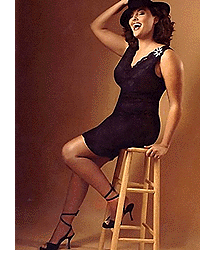
SW: I have to say, the main thing about these girls is, they treat their bodies like temples. They eat. This is the number one thing that I will say about plus girls. They eat. And it has a lot to do with their brain power, and the way their bodies function, and their temperaments, actually. Because when you don’t eat, you get cranky. When you get cranky, you’re nasty to people. And when you’re nasty to people, nobody wants to work with you. And I can tell you that there are a lot more straight-size girls with that reputation than there are plus girls. Also, when I’m in a room with the girls, I see how men look at these girls. I don’t care if they’re with sticklet models who look like toothpicks, their heads swivel like pez dispensers to look at these girls walking through the room. HSG: To look at the plus-size models. SW: To look at the plus girls. On the streets of Manhattan, I thought there were going to be accidents. Men did not know what to do with themselves when they saw these girls walking down the street. It’s like, it’s almost taboo to people. HSG: That reminds me of Tracie’s notion of “dangerous” curves—that this body type is threatening. It has the allure of the forbidden. I love the picture that you paint, of the man who is with the waif, but yearns for the plus-size girl. SW: I see it at parties, I see it in the street, I see it everywhere. We’re doing photo shoots outside, on the street, and people stop. I was doing a photo shoot and I had a girl in her bra and underwear, and she was standing on kind of on a secluded street, and a police officer drove by. And normally, in a lot of places, somebody would be getting a ticket for indecent exposure. But it is Miami, and they are used to us a bit down here. And the cops get on their loudspeaker and they’re like, “Anything we can do to help you girls?” They’re like, “Honey, you look phenomenal!”And they ended with, “We’re here to serve and protect!” HSG: Have you seen progress in plus-size fashion—an expansion beyond the confines of career wear? SW: Absolutely. Bravo to Lane Bryant for finally getting it right. I have been a Lane Bryant shopper for years, and I was actually in one of their stores today and was just so impressed with the edginess of it, with the varieties and the styles. It was like walking into Express. HSG: To me at least, it appears that women’s fashions have been becoming increasingly feminine of late, with the ruffled blouses, the big jewellery… SW: Femininity is coming back huge. HSG: And do you see this as a trend, or as something that will last? SW: From what I’ve seen from a lot of the mainstream designers, they’re keeping it very feminine for the next couple of seasons to come. 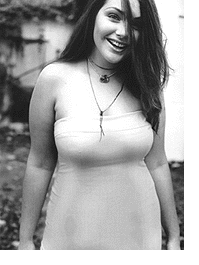
HSG: I wonder if the proliferation of plus-size fashion doesn’t have something to do with this. Since full-figured models bespeak femininity in a way that androgynous, straight-size models do not, perhaps they have helped to usher in the new femininity. And has there been a move to embrace form-fitting, body-conscious styles? SW: There has been. Something that I found out a long time ago is, bottom line, there is nothing wrong with wanting to look good and feel good in your clothes, and nothing wrong with plus girls wanting to look sexy, and feel sexy, because when I was plus, all I wanted was something that was low-cut and sexy, and made me feel good, and now those options are out there. I have no problem with plus girls exposing parts of their bodies and feeling sexy and looking good, and bravo to the ones who have the courage to do it. A lot of people are still stuck in, “Well, I can’t wear that, that’s too trendy for me.” And it’s not. You just have to know what looks good and what works for you. HSG: It’s amazing how all those restrictions have fallen by the wayside. It even used to be a taboo for plus-size models to wear sleeveless attire, and last year, sleeveless was everywhere. SW: It was. HSG: So what will be the next taboo to fall? The bare midriff? SW: I was fortunate enough to go to the Lane Bryant show in New York last February, and the stuff I saw come out on the runway was hot. I think they should continue on that trend. And I saw bare midriffs, and I saw sexy lingerie. HSG: How did you enjoy that show, as a spectator? Was it your first? 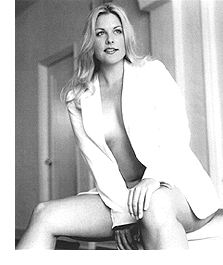
SW: It was the first Lane Bryant show for me. And I’ve been to several fashion shows before. I’ve been a dresser in shows, and an observer at shows, and I truly, thoroughly enjoyed this show most of all. It was an amazing night. And then I crashed the Ford party, which was a lot of fun too. All the Ford plus girls were really nice to me. HSG: You had an opportunity to meet them? SW: I got a chance to meet a lot of the different girls because I was with Tracie, Kati Kochanski and Courtney, and we knew a few of the other girls, so we went and we spent some time with them. HSG: Did any of them stand out to you? Did you find yourself thinking, “I would like to work with her, someday”? SW: One of my biggest thrills of the night was meeting Kate Dillon. I had never met her before. And when I had first started in this business, I remember being home in New York over the winter, and going to the city by train, and I saw the first plus billboard I had ever seen, and it was her, for Elisabeth, and I looked at it and I said, “I want to work with girls like that.” HSG: It inspired you. SW: It totally inspired me. And I’ve followed her over the years, and I’ve seen all the things she’s done, and she’s a nice girl. She was very nice, warm, and receptive. HSG: Your Barbara Brickner test with Douglas B. attracted a lot of attention among aficionados of plus-size modelling. Tell us a little bit about the background of that shoot. 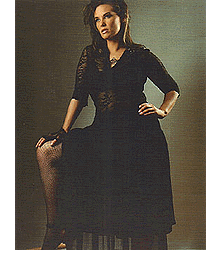
SW: I love Barbara. I met her when I did that shoot with her, and I absolutely loved her. I knew she was a good friend of Tracie’s. For years I had been hearing about her. She was in town, she came to my house, she met my mom, she came over for the evening and hung out, she’s just so wonderful and so sweet and so genuine. HSG: Yes, I’ve heard that. Everyone who has met her speaks of her in such a positive way. She almost sounds like a saint. SW: She is, she really is. Her temperament is extraordinary. HSG: How did you assemble the outfits for that shoot? SW: In one of the images I did with her, she’s wearing a skirt that Donna Karan did this season, the same exact skirt. My mother had actually designed it back a couple of years ago to wear, and it’s tears of material. I pulled this shirt, and I wasn’t sure what I was going to do with it, and it worked. It worked on her, she knew how to work it. It’s about a model. If a model can’t pull a look off, then it’s not worth doing the look on her. And Barbara can pull anything off. HSG: Considering the fact that her temperament is said to be so sweet, it’s amazing that she so successfully projected a darker, more sensual image in these shots. It appears to be a skill of its own, rather like acting. SW: It really is. It’s the persona you get into to shoot what you’re shooting. She can do it. Tracie’s another one who can do it. HSG: The clothes match Douglas B.’s nocturnal, Rembrandt-like vision so well. Did the fact that you were shooting with him influence your choice of attire? SW: That didn’t really enter into it. I worked with Doug all summer, through Wilhelmina. His style is very easy to work with as well, and he and I would talk about what we were seeing with a shot. If I don’t have a fitting with a girl before, I always bring extra looks. So if I’m shooting three looks, I have six outfits. There are always choices, because not everything always works. 
HSG: Did you let Barbara choose among different looks? SW: We tried on different things, we put different tops together with different bottoms…I was actually really nervous about shooting with Barbara. I don’t get nervous about shooting girls, because I test girls all the time, that’s why the agencies call me, they listen to me, I know what I’m doing, but this made me nervous. HSG: Why? SW: Because it was Barbara Brickner! I guess my friendship with Tracie makes it so that I’m not as nervous in that case, but I still get stressed when I pull for Tracie. HSG: You do? Why? SW: Because she’s on the edge, she’s always five steps ahead of everybody else in how she does her tests. And her tests are totally different than most of her work. She likes tests in different extremes. HSG: How did your affiliation with Tracie begin? SW: It actually began with Ricardo at Irene Marie. He called me and said, we have this girl, do you want to test her? And I said, sure. And I tested with Tracie, and it was a fun test. It was one of my more…I want to say outrageous tests, more my first editorial kind of test. And she was a dream to work with. There were little glitches that day, but she was a pleasure to work with, no stress, no nothing. HSG: There was chemistry between you? SW: There really was. We built a friendship out of our work together, and we started working together more and more. Last January, I started working with her on her charity. And within the last two years we have become really close. And I had the most amazing adventure of my lifetime in Australia with her. HSG: Oh, you were with her on that excursion? 
SW: I joined her on that. It was one of the best experiences I have ever had in my life. I was at the show for the Australian Fashion Week. At a show, when people like something, they will usually clap. But this was the most silent, unenthusiastic crowd. And all of a sudden, here comes Tracie strolling out in this see-through pink shirt, with nothing underneath, and they were cheering. I got chills. It was so beautiful. HSG: One of your shots with Tracie particularly struck my attention, one in which she is wearing a pink corset, a skirt, and a top. It’s very feminine. How did you assemble that outfit? SW: The skirt is an antique skirt that my mom had found a couple of years ago in an antique store and I came across it in the attic and thought, this is really pretty. The corset I had gotten at H&M in New York over the summer. The vintage chiffon shirt was also my mother’s from the ’70s. Fashion and shopping and style go back generations in my family. My mother was a designer. My grandmother was a model as a young girl. That’s why I love this business. My mother saved a lot of things. She just knew that it would be spectacular again, and she allows me to go shopping in the attic, so to speak, when I’m home in New York. She saved all of my grandmother’s hats from the ’50s, which I actually used for Tracie on a shoot. HSG: Oh yes, I’ve seen a few of those shots. SW: That was me working on what I like about fashion. I liked when ladies got dressed up to go to lunch, or when people got dressed up to go to the theatre. 
HSG: Things were a little more elegant then? SW: I think that we have lost so much elegance as a society. HSG: Do you see fashion as an area in which it might be brought back? SW: Absolutely. I think that people should get dressed up. As a small child, I would go to Manhattan to go see theatre, and I had to be in my dress, and my little white tights, and my black Mary Janes. I don’t care if it was a matinee, or evening theatre, you were dressed like a little lady. Your overcoat, your little hat that matched, whatever it might be. You were dressed like a lady. Now you go to the theatre, and people are in jeans and a t-shirt. HSG: Yes, you see that “business casual” look even at the opera, sometimes. People don’t celebrate cultural events any more, which is such a shame, such a loss… SW: I think a lot of people are afraid to do it. I think people are afraid to show their creativity in their fashion. They think that they need to do what society dictates. HSG: And that is right in line with the forbidden appeal of the fuller female figure. What is your greatest ambition as a stylist? SW: My greatest accomplishment would be doing a plus-size layout in a high-profile fashion magazine. I was a big fan of MODE, of the magazine. The fact of the matter was, it was a great magazine, and it’s a shame that it’s not in business, because I think it really did make a difference. 
HSG: And it changed people’s lives. Do you ever think about that, about the fact that your work, the images which you help to create, can have such a profound impact on people? SW: You know what, I hope it does. I hope that my work makes a difference. The basic common sense of it all is, most people in this country are a size 12 and above. That’s plus. That’s real. People are real, these girls are real. And that’s the bottom line. People want to see real. People feel comfortable with real. HSG: As opposed to artificial. SW: Which is what many magazines create. HSG: So, if that’s what the public prefers, then why does the fashion industry favour emaciation? SW: Because no matter what society thinks in small groups, on the whole, they have been taught to think, skinny is better. “Thin is in.” “You can never be too thin.” And it’s wrong. I tell people, if you are comfortable with yourself, then people will be comfortable with you. If you radiate an aura of comfort in your size, if you’re size 10 great, if you’re size 16, that’s fine, that’s you, that’s who you are. Don’t give in to society. |
You may contact the author of this page at:
You are cordially invited to visit:
